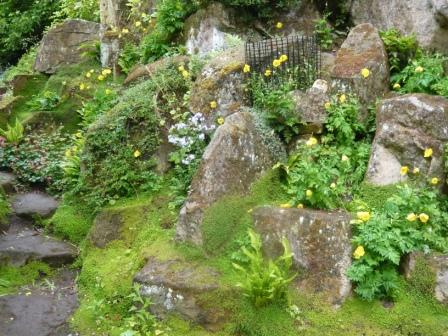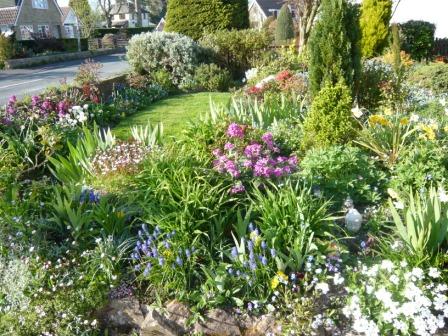Making A Rock Garden or Rockery
A rock garden is a grand place to display your alpine plants. You can shade them with rocks, provide deep root runs and provide rain cover with perspex roofs

In Alpine conditions plants can shelter behind rocks that give them protection from wind and rain and help with drainage. Try to give your plants similar conditions to there original habitat and they will repay you for your attention to detail.
Tips for Making a Rock Garden
- A rock garden should be open and unshaded by over hanging trees
- There should be a slope either natural or built up. This allows plants on the North facing slope to receive 25% of the sun (and heat) of those on the South slope so those delicate plants don’t fry.
- Study the prevailing wind so you know where most rain will fall and plant the rain shadow area with plants that need to stay dry.
- If in doubt about drainage improve it by adding grit. If the soil is clay, a pile of brick rubble 15 inches below the surface will aid drainage no-end.
- The soil can be average soil but will not need extra nutrients or fertilizer except for special situations. Pack all crevices tightly with soil to prevent unwanted pests like mice.
- Plan your rock positions and lay the grain or style of rock all in the same direction. Do not mix rock types or the harmonious effect can be lost.
- Do not plant higgledy piggeldy but select plants that fit into a simple plan. Keep slow growing plants needing similar conditions together. Consider haveing zones in the rockery for different plant requirements.
- Mulch new plants with pea gravel
Plants that grow in this low rockery include spring bulbs, Primulas, Aubretia, Campanulas, Saxifrages and low growing conifers.
A number of stones are placed in a way they can be walked on for access to maintain the Rockery
The careful selection of plants can provide colour throught out the seasons eventhough Spring is seen as the key time for Rockery flowers.

If you are planning to build a rock garden (and I suggest you do need to plan) then here are a few tips that will help you avoid some of the problems I have encountered.
More Rock Garden Tips
- Modern rock gardens can be a collection of standing stones looking like abstract sculptures, a formal Zen like Oriental space or a gravel garden with shapely rocks and rectangular constructions. I favour the informal Alpinesque Rockery that is primarily designed to provide a variety of habitats for plants.
- Consider the gradient in your garden as sloping gardens can be difficult to landscape in a formal manner. An informal Rockery needs to be firmly anchored with standing places for maintenance and culture.
- Aim for rocks with texture and character that harmonise with the local environment.
- Site your rocks in a display that is a pleasing feature in its own right before any planting.
- Consider the background, whilst most plants may be low growing a green shrubby background may set off the whole feature.
Choosing Stone for your Rockery
- Use local stone that fits in rather than detracts from the environment. If you have granite or slate locally then pale limestone can look very out of place.
- Aim for large stones as at least one third will be buried and size does matter.
- Try local quarries for stone rejected by builders as unsuitable for their purposes or salvage yards and tips.
- Do not skimp on the quality and quantity of stone.
Design Considerations for a Rockery
- You need access and the ability to move around the edges (I have difficulty getting the lawnmower where I need because I put the rockery to near a wall.)
- Work out your budget to get as big a rockery as possible with enough rocks without going bankrupt in the process.
- Arrange a transition area between the rockery and formal parts of the garden such as an edging or path with small stones or tufty grasses.
- Plan each stones placement with a staggered or layered effect from the main viewing point(s). Create planting pockets and space plus horizontal and vertical planting crevices.
- Place stones tilted backwards so they protect plants and do not cause water to run on to them causing rotting.
- Aim to keep the rock strata evenly matched and running in the same direction not just piled up or sprinkled aimlessly.
See also Rock Gardens in Miniature
